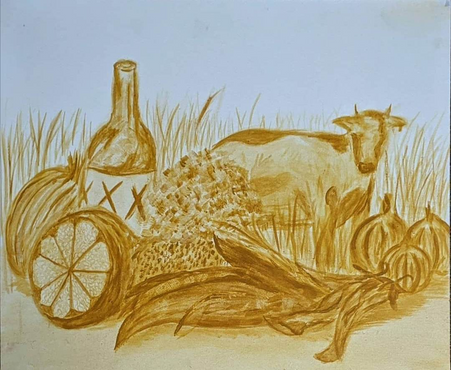ART 309
Description: Sequential semesters focus on art learning theory, teaching methodology, and pre-student teaching clinical experiences in Art Education K-12. Must be repeated by Art Education major for a total of 6 hours (2 consecutive semester sequences starting in fall). Clinical Experience: 20 hours.
Rationale: This semester, I focused on a single lesson plan that was used in practice. Then I developed it into a larger unit plan.
HOIC Lesson plan and how to video
Description: Illinois State University held a day for two class periods to attend our campus to work alongside students in the art education department in workshops designed and led by the students themselves.
Rationale: The lesson I proposed is a lesson based on the idea of getting to know someone on the surface and getting to know ourselves more deeply. The workshop was focused on the conceptual idea of how to build ideas and communicate in a discussion in how to approach perspectives.
Perspective of self and others
Description: Students will answer surface-level prompts about themselves, and partners will illustrate these answers using drawing materials. Students will then answer prompts about themselves that require higher-level thinking and illustrate their answers using drawing materials. This unit will open students to discovering aspects about themselves and others. Students will also learn to be more open and perceive how interactive questions can discover others
Rationale: After using this lesson in a classroom setting for a single day, I learn from my experience how to improve the lesson and expand the student's skills in drawing and comprehension of the project by applying many methods of teaching and supportive materials.
the goal of the unit is to have the students find themselves in other people's eyes and to find themselves through their very own. Moreover, the lesson expands o how we address questions to have a certain level of understanding of an individual.
Artist Handout
Description: The artist handout is to assist the student in understanding and making connections to the artist the teacher is presenting and how it applies to their unit lesson.
Rationale: The artist I chose was Amy Sherald, she makes portraits based on the perception of how she paints her figures using her ionic grayscale approach. Amy Sherald brings in the idea of how black people in America are perceived to be politic in the media, yet they are hardly seen as individuals. using this concept of what is perceived and what is real helps bring out the idea of the unit's big idea on how we as individuals have impressions of people and ourselves.
Literacy lesson
Description: the literacy lesson is used to expand the student's vocabulary and to articulate themselves when it comes to works of art art.
Rationale: Jambaord I used is based worksheet i provide to the students as a way to brainstorm ideas. This jam board will assist students to know to interact with the mind maps and how to use them to communicate where and how they came up with their artwork.
Rubric
Description: The rubric is used to assess the student's performance within the unit, both formative and summative.
Rationale: although the unit lesson can be open to the student's independent style and concepts, the rubric creates a foundation for how the teacher collects data on what the students completed and incomplete.
Unit's Artist statement
Description: The artist statement is used to describe and elaborate the teacher's ideas behind the unit's goal and the artworks they present in class.
Rationale: The artist statement I created dives into the conceptual ideas, artistic choices, and inspiration I had for the unit.
Class worksheets
Teacher's Materials: Demo video, PowerPoint presentation, and examples
Description: The teacher materials are to assist them in the unit and guide the students through various amounts of media.
Rationale: The materials I chose are my mind map video guide, art examples, and PowerPoint. these materials provide students to interact with the lesson in three different ways visually: stationary, animated, and interactive.


